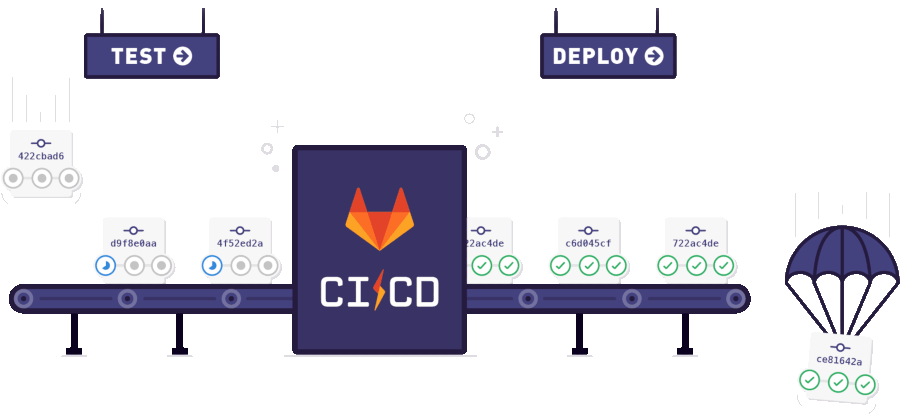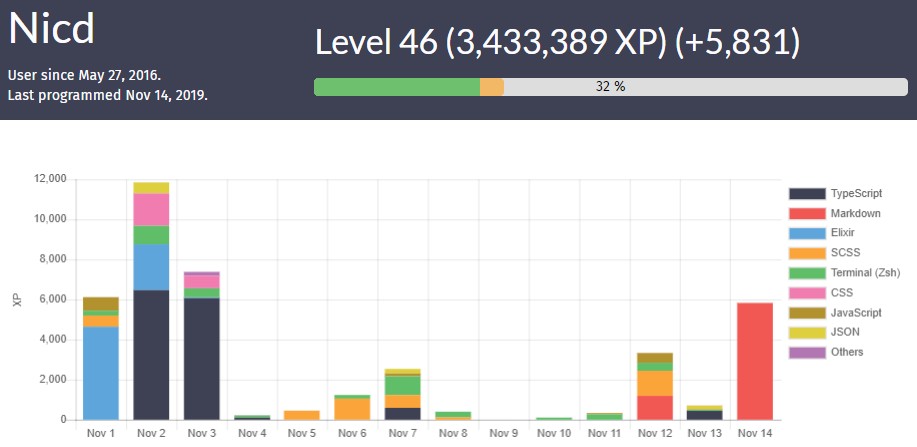INTERVIEW 009 #rails
Running a Website Monitoring Service with a Boring Technology
with Jamhur Mustafayev
INTERVIEW 008 #static-site
Learn How to Excel at Engineering Management with Developer to Manager
with Siddhant Goel
INTERVIEW 007 #dotnet-core
A Site Where New Quidditch Referees Can Take a Test to Officiate Games
with Marian Dziubiak
INTERVIEW 006 #angularjs
Altair Is a Feature-Rich GraphQL Client IDE for All Platforms
with Samuel Imolorhe
INTERVIEW 005 #nuxt
Postwoman Is a Free, Fast and Beautiful Alternative to Postman
with Liyas Thomas
INTERVIEW 004 #koa
Daily Is a Browser Extension That Replaces Your New Tab with Dev News
with Ido Shamun
INTERVIEW 003 #flask
A Recipe Search Engine and Aggregator Called Recipe Finder
with Bruno Oliveira
INTERVIEW 002 #phoenix
Track How Much Code You Write & What Languages You Use with CodeStats
with Mikko "Nicd" Ahlroth
INTERVIEW 001 #static-site
100k+ Page Views a Month for $5 with a Self Hosted Static Site
with Nick Janetakis
Are you running a site in production? I'd love to hear your story, get interviewed.
Track How Much Code You Write & What Languages You Use with CodeStats
- #phoenix
- #elixir
- #appsignal
- #gitlab-ci
- #hetzner
- #hetzner
- #lets-encrypt
- #mailgun
- #nginx
- #open-source
- #postgres
- #systemd
- #ubuntu
What’s your background and what site are you running in production?
My name is Mikko Ahlroth, and I’m a software developer working at Vincit Oyj, mainly with Python and JavaScript based projects. I’ve also been working with Elixir in my free time since version 0.10 which was released in 2013.
Code::Stats is a statistics service for programmers that I’ve been working on in my free time.
It records what languages you’re using and it does this using a plugin that you would add to your code editor. It supports VSCode, JetBrains, Sublime Text, Vim, Atom and more.
This data is visualized in different ways on the website. For example, here’s my profile:
I’m the lead developer and administrator of the service. I’ve made about 80% of the commits but there are also other contributors – especially around adding support for editor plugins.
The website along with the code editor plugins are open source. You can find the repos at https://gitlab.com/code-stats.
The project has been live since May 2016. During work days we have around 60 to 120 API write calls per minute. On a monthly scale this means around 2.1 million API hits. So this is the view of a small’ish Elixir service. We are currently running on Elixir 1.9 and Phoenix 1.4.
What motivated you to use Phoenix / Elixir?
The first modules of Code::Stats were written during a hackaton event at my company.
I started with Phoenix because I was (and still am) very excited to use Elixir and Phoenix. Phoenix is Elixir’s most popular web framework. The Phoenix channel system for real-time updates was also a factor, as it allows for updating the user profiles and other parts of the user interface right as data comes in.
For example, if you visit the home page, each dot that appears on the map is pushed out in real time over a Phoenix channel.
The choice of Phoenix has worked out very well for the project. There is plenty of help material around and the guides are generally very good. It’s also very featureful, covering most aspects of typical web services, and has many support libraries from the community.
Before working on Code::Stats, I had written a blog engine in Phoenix, so it wasn’t completely foreign to me. As for Elixir, I had been working with it on and off since 2013.
Is your site a monolith or broken up into microservices?
Code::Stats is a monolithic service. All the code is contained in a single project and the build artifact is a single release that gets run.
The release starts multiple app specific Elixir processes such as:
- Request process pool
- Ecto (Elixir’s main data mapping library) process pool
- Channel processes
- Various processes that cache data
- Periodic tasks on a timed interval
If we wanted to, we could have strict microservice-style boundaries between the different parts, but the service is still simple enough to not warrant the effort required for that.
Currently the back-end code base is around 5,200 lines of Elixir and Embedded Elixir (EEx) templates, in around 120 files.
Keeping the project as a monolith and inside of one Git repository helps keep the development overhead low. In my opinion starting with microservices and multiple repos from the beginning is a waste of effort for little gain and much hassle.
You can get very far with a monolith, and as long as you keep it internally organized, you can split parts out later. Prematurely going for microservices may lead to a distributed monolith, where you get the flexibility of a monolith, but with distributed problems added into the mix heh.
As for Git, if a mono repo works for a project as big as the Linux kernel, it surely works for any site I might envision making!
Are you using server rendered templates with sprinkles of JavaScript or is there an API based back-end with a JavaScript heavy front-end?
The service uses mostly plain old server rendered templates. Most of the pages need very few interactions and EEx templates are easy to reason about.
There’s also no extra thinking about SEO since pages can be crawled by bots. For the pages that do have interactive elements, RE:DOM is used. Some pages only have a bit of it and others like the profile page render the whole content area using JavaScript.
This was yet again both a choice of pragmatism and learning. The pragmatic aspect comes from the history of Code::Stats.
The front-end used to be written in Elm. It was a new and fancy language and I was really excited about functional programming. What became an issue was the low speed of development I had due to the Elm way being quite foreign to me.
So I made a choice to drop Elm in a refactor and write JS, which I knew very well. At the same time I picked up a new (to me) framework called RE:DOM, because it was very minimal and didn’t get in my way. I took a look at Angular, React, Riot, and even BuckleScript before going with RE:DOM because I felt it was close to plain JS but abstracted the most painful points of the DOM, and I’ve been quite happy with it.
As mentioned, the front page of the website and the individual user profiles use Phoenix channels for live updates. The RE:DOM code hooks into Phoenix’s channel events and delegates updates to the various components on the front-end. That part has worked out extremely well.

On each API call we fire a broadcast to the user’s channel (for those viewing their profile) and the front page’s channel. If there’s no one listening to a channel, it’s (nearly) just a no-op, so we don’t need to worry about wasting compute cycles or bandwidth.
I’m happy with our technology choices so far, though I’ve been planning on rewriting the JS parts in strict TypeScript for better reliability and IDE support. Additionally the Chart.js library is sometimes quite clunky to work with and fills most of the size of our JS bundle, so its replacement is being planned sometime in the future.
As for advice for others, think about balancing the popularity of a tech with its fanciness. I’ve made many choices to learn the newest, coolest, bleeding edgest frameworks and tools (and even wrote some of my own), just to learn the pain of not having proper support.
Phoenix and Elixir have great support resources even though they are smaller in popularity.
But in the front-end world you can end up in a really small niche and end up shouting into empty chat rooms for help. And that’s never fun when you want to get stuff done.
What does the rest of your tech stack look like?
The rest of the tech stack is very standard for the most part. Everything runs on Linux, which is a no-brainer as a choice. PostgreSQL offers best-in-class database features and is well supported in Ecto which comes included by default in Phoenix apps.
Then there’s nginx which terminates TLS, serves static files and acts as a proxy for the Phoenix application. I’ve always been very impressed with nginx and it’s my default choice for any web serving needs nowadays.
For SSL certificate registration I’m using acme.sh. I picked acme.sh for its simplicity and Unix philosophy. I configure it to fetch the certificate and put it in a certain directory and handle the rest (like reloading it into nginx) myself. It has no dependencies other than Bash, which is nice.
Caching is done both inside of Elixir using ETS (Erlang Term Storage) and in the database. On startup, a couple of processes boot and read data from the database to store in ETS.
When API calls from users arrive they also update the data in ETS. ETS is then used for example to render the front page very quickly. Each user additionally has a cache in the database as a JSONB column, which can easily be extended to add new datasets. It keeps track of aggregate data that would be too expensive to calculate on each page refresh.
Using JSONB columns as needed inside of PostgreSQL is a nice way to get the benefits of a flexible NoSQL database while still being able to use PostgreSQL.
Which external SAAS tools does your site depend on?
We are using two SaaS providers: Mailgun and AppSignal.
Mailgun provides us with transactional email sending. It’s currently only used for password reset emails, but there is mass mailing capability written into the code. For example, from the server I can open a shell into the running instance to send a one-off email to all users but I’ve yet to use that feature. Mailgun was chosen for its simplicity and free tier that is completely enough for us.
AppSignal offers us monitoring and error logging tools for the service. Any crashes and abnormal operations are logged and notifications are sent to me via email. I can also inspect historical data about the server’s performance.

It’s a very useful service and they are providing it to us free of charge. I’m very grateful for that, and it has helped manage the service considerably. Because I know it alerts me of issues, I can sleep more soundly. :D
Which cloud hosting provider or platform are you using to host everything?
Code::Stats runs on a very traditional setup of a single VPS. We used to have a dedicated server from online.net, but its disk I/O proved to be slow due to having just a regular HDD.
To alleviate the issues, we moved to a VPS from Hetzner that has access to SSD storage. It has 4 virtual cores and 16GB of RAM. Due to being a small service and the efficiency of Elixir, this serves us very well and there’s lots of room for growth. The cost for this is around 24 € per month.
The current server is running Ubuntu Server 18.04 LTS. It’s a pragmatic choice in that it has a lot of support and is quite stable. The original server ran Arch Linux but lately I haven’t had time to keep upgrading it constantly; Ubuntu is a bit more relaxed in that sense. :)
How many servers does your app run on and how do you manage them?
Everything is done on the same server. PostgreSQL, nginx and the Elixir release of the service all run on the same machine. Code::Stats uses around 200 to 300 MB of RAM. That leaves a lot of memory to be dedicated to PostgreSQL for greater in-memory caching.
There is also a separate similar server for the beta instance but both production and the beta server each run on their own single and separate server.
A VPS was chosen because I’ve been running Linux servers for years. Setting it up is quite routine so I have not bothered with a deployment / configuration tool such as Ansible, or containers.
What does your deployment process look like?
There are two different deploy processes for Code::Stats, one for the beta instance and one for production. The beta instance is automated and production is currently done manually.
Whenever a commit is pushed to the master branch, GitLab CI builds the project, runs tests, and updates the documentation. It also pushes the version to the beta server where a GitLab CI process installs the dependencies, builds a release, migrates the database, and finally restarts the instance with the new release.
The whole process takes a few minutes.

This was automated because manually doing that for all commits in master would be unwieldy. There is the overhead of maintaining the CI process though, which may break due to changes in the project structure or installation procedures.
For production, this is not necessary due to releases being somewhat rare. When it’s time to make a new release, it is built in a Vagrant box that mimics the production server. The built release is transferred with scp and extracted over the old one. Database migrations are run and then the systemd service is restarted. This works well when the procedure is as simple as this.
Each production deploy results in about 10 seconds of downtime, or more if there are database migrations that need the old instance to be shut down first. This is fast enough for such a non-time-critical service in my opinion, so I haven’t spent effort in faster deploys or hot code reloading.
How have you planned for disasters, unexpected events or malicious users?
Hetzner handles performing an automatic backup of the machine every night.
There is a script on the server that dumps the database every night to a file so that the backup process can take a copy of that file instead of the raw PostgreSQL data files. The script also deletes backup files that are older than a set date. The service has no user generated content outside of the database, so only that needs to be backed up.
The server has been configured to restart the service if it goes down. This is done using systemd’s restart policies. In case of issues with that, I will get a notification from AppSignal that the service is not sending data. There are also other notifications in AppSignal that alert me of different things with the service, e.g. all crashes are reported.
Otherwise the server is protected as much as I know how to. The SSH and HTTPS configurations have been hardened with modern settings, such as only SSH key based logins are permitted.
What’s your advice for others who are running similar sites in production?
One thing that comes to mind is not to let the modern web development world overwhelm you. There are a lot of tools and complexity that you feel you “have to use” to run a service. Docker, Kubernetes, microservices, single-page apps, and so on. All this can discourage you from starting.
Yet there is nothing wrong with a simple single-node service that serves server-rendered HTML like Code::Stats for example. With Elixir, you can use the resources of a single server more efficiently and go quite far before thinking about more complex setups.
What I wish I had thought more when writing Code::Stats was grouping up the modules a bit better. Phoenix nowadays has good guides for that with contexts, but when I started using it, I was totally new and some controllers are still quite messy from that.
Good code organization will help you a lot down the line. With Elixir it’s quite different from other languages in some parts, but the more you write the better you get at it.
I’m not an avid reader of programming books, so the way I got into Elixir was that I read through the getting started guide on the website and just started hacking away at it. That worked well for me, but from what I’ve heard, the books Programming Elixir by Dave Thomas, and Elixir in Action by Saša Jurić are highly recommended.
Note that due to the fast moving nature of the language, there are outdated editions of many books, so you have to check to get an updated one.
The Elixir community is a very friendly one. I myself frequent the #elixir-lang IRC channel on Freenode as “Nicd”. There’s also the Elixir Forum, a Discord server and a Slack channel.
Where can we go to learn more?
If you want to discuss anything related to Code::Stats, please join our Discord server at https://discord.gg/gyzRfjc.
You can also send a tweet to @code_stats. I myself can be found at @AmNicd and I’m happy to talk about all things Elixir. :)
– Mikko “Nicd” Ahlroth, Elixir enthusiast / Code::Stats lead developer
Nov 18, 2019 (Updated on Nov 19, 2019)
✏️ Edit on GitHub 📜 View Updates